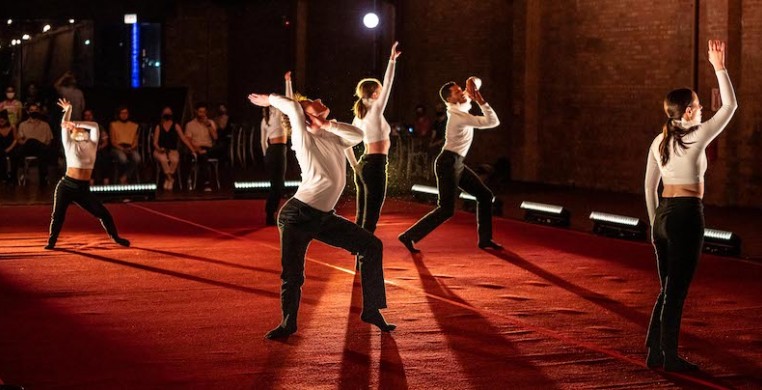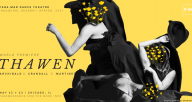A true testament of any new company is not their first show, but their second. Choreographer and now artistic director Stephanie Martinez launched Para.Mar Dance Theatre during the height of the pandemic; as one of the first Chicago dance companies to put on a live performance after COVID-19 halted arts organizations writ large, they are now also one of the first to venture indoors. Throughout the weekend, Para.Mar performed to crowds of up to 75 people at a time at Rockwell on the River, an Avondale event space tucked between Metropolitan Brewing and Metropolis Coffee.
Entering on Sunday afternoon, it did, indeed, feel a little like walking into a wedding reception, with popping prosecco corks punctuating the palpable buzz of real, live humans hugging one another and talking together. If you saw Para.Mar’s inaugural concert in a parking lot last October, there’s a lot here that is familiar. Umbrellaed under the title “THAWEN,” Martinez segmented and reorganized her magnum opus called “Kiss” from last fall and inserted premieres by Lucas Crandall and Jennifer Archibald. Martinez reused the merlot-tinted industrial carpet from “Kiss” and divided it into three dedicated performance spaces, each with a half-pipe jutting toward Rockwell on the River’s high, wood-beamed ceilings. Over the central performance area, under a skylight, is a gorgeous, golden, drippy forsythia chandelier (created by dancer Noelle Kayser with set designer Andrew Boyce) that changes throughout the 90-ish minutes of performance according to shifts in natural and unnatural light (coming from the skylight, a huge bay of windows overlooking the Chicago River and a handful of light trees and floor strips brought for the occasion by lighting designer Jackie Fox of Strong Fox Designs). Also familiar: most of the dancers from the “Kiss” premiere, with former Hubbard Street dancer Myles Lavalle and Nathaniel Hunt tagging in for Joseph Hernandez and Brian Martinez. Archibald and Crandall’s pieces drew from the same dancer well, with a smaller group performing the former while the latter was danced by soloist Ching Ching Wong.
On that point: These are, undeniably, some of the best concert dancers around, but I’m not sure whether or not it served the concert as a whole to recycle them for each piece. “Kiss,” broken into three chapters and sandwiching the other two pieces, served as a kind of anchor to the evening. By being asked to continually leave “Kiss,” and watch the same dancers do something else in a different area, it’s hard not to try and see these pieces as somehow related. They’re clearly not, but this format dilutes what could otherwise be really strong nuggets from Crandall and Archibald if allowed some breathing room from “Kiss.”
Yet, there are distinctions. Wong is simply mesmerizing in Crandall’s “Threshold.” The piece begins with her propped on hands and toes in a crouch as if ready to pounce but going nowhere as her feet slide in a tempo-growing mountain climber on her patch of burgundy rug. Once she stands, Wong moves through a patterned series of gestures and convulsions. The score, a mix of Teal, Bach and Kimiko Ishizaka similarly runs in a loop that is partly maddening. Only partly. “Threshold” is an anthem for these times. Wong is alone—isolated—cycling through varying emotions that crescendo from ambivalence to rage—rage toward herself and, more rarely, toward us, the audience. She seems stuck, destined to repeat herself. As the theme from Bach’s “Goldberg Variations” eventually claims prominence over the sound, this music—arguably one of the most beautiful piano themes of all time—has no effect on Wong. Like the other two pieces in “THAWEN,” there is no resolution. It just ends.
By the time I settled back into a chair in the main performance space across the room, Wong had already changed back into her black pants, white crop top and Elizabethan ruff, shape shifting back into the Mozartian, quasi-goofball characters of “Kiss.” This middle section, however, is more somber and meditative, with long, lingering solos, locked-lip pas de deux and a diversion from the mixtape of orchestral greatest hits with reflective original music by Darryl J. Hoffman.
Archibald’s “Walk” is a well-crafted example of this choreographer's catalog, which is not seen often enough in Chicago. The quintet (Lavalle, Hunt, Kayser, Chase Buntrock and Kelsey McFalls) maneuver Archibald’s vocabulary well enough—it’s an ever-so-slightly jazzy take on contemporary ballet with a splash of hip-hop thrown in—though they are clearly less comfortable here (and understandably exhausted after dancing non-stop for an hour already).
I kept trying to put my finger on what’s missing from this piece. And honestly, I think that feeling is actually the point. Archibald offers a quote by Thich Nhat Hanh as her program note: “When we walk like (we are rushing), we print anxiety and sorrow on the earth. We have to walk in a way that we only print peace and serenity on the earth… Be aware of the contact between your feet and the earth. Walk as if you are kissing the earth with your feet.” While I kept hoping for some kind of driving pulse, a downbeat, a loadstar to thrust this piece into some kind of rhythm, Archibald and composer Raúl Pastor Medall are masterfully restrained, as if to say, “Sit with this.”



